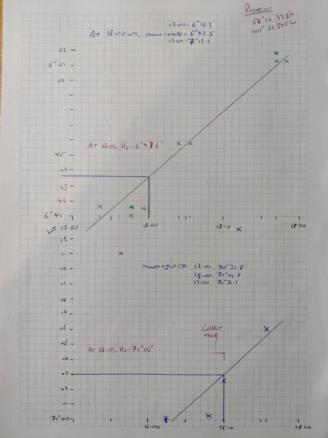
NavList:
A Community Devoted to the Preservation and Practice of Celestial Navigation and Other Methods of Traditional Wayfinding
From: Jonathan Ho
Date: 2023 Feb 14, 13:57 -0800
Hi Modris,
Thanks for your interest and questions about my lunars, this is a very welcoming place.
I did take several observations of each and graphed them out, as in my attached photo. The strange and irregular groupings of the sights are due to the cold weather (which led me to hide indoors a lot!) combined with impatience (i.e. taking 2 sights in quick succession once outside, rather than waiting a more regular interval between them).
I attempted Mars first, being a nice easy 6 degree distance, and then almost as an afterthought decided to try Jupiter. I believe a few things could be attributable to the large Jupiter error. Any comments you have on these points would be much appreciated.
- I found it much harder to keep the sextant steady at the larger 70 degree angle while trying to keep both bodies in view. I was getting quite tired arms from trying to hold the sextant, and gripping it tightly as I didn't yet have a neck strap so was afraid to drop it (I have now fitted one as shown in The Sextant Handbook so would feel more comfortable to rest/relax my hand grip)
- I was using the standard 3.5x40 scope that came with Francis' Astra sextant. I suppose a 6-7x scope would give a better view, but I don't have nearly £300 to spend on one and have read that it makes lunar sights at sea more difficult with the boat's movement.
- I may have been aiming for tangency of Jupiter with the moon's near limb, instead of bisecting the centre of the planet's disk. I didn't even think of using shades for Jupiter (though of course did for the moon). So perhaps this contributed to the error (if I had gone for the centre, this would have increased the lunar distance slightly, which would work to correct my error...I think?).
- The final possible error that I found to be quite difficult, and made me question the accuracy of my sights, was sweeping the arc to find the maximum distance. It felt like I needed a combination of yawing, rolling and translating the sextant in order to have the arc in plane with a great circle, which I found very difficult to achieve while still keeping both bodies in view! It probably just takes practice. But I was reasonably skeptical that I had achieved a proper "kissing" of the two bodies each time, however it was getting late and cold enough that I was ok to leave it as it was.
Thanks for the tip about the online calculator and height of eye. I did wonder why it was necessary, so that makes sense!
On a side note, while looking back through archives I noticed that Frank considers Bruce Stark's tables to be a historical oddity, and not as simple or transparent as, say, Thompson's tables. What is your preferred manual/tabular method for clearing lunars?
Jonny







